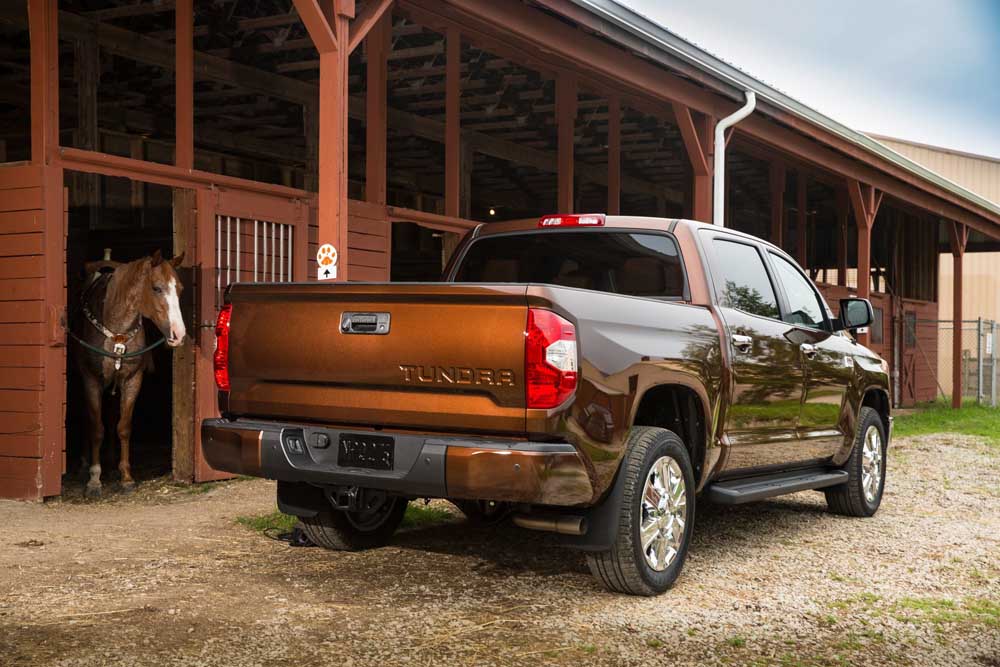Tundra gets a Texas touch
Published 12:00 am Sunday, December 8, 2013

- David Dewhurst / Toyota via McClatchy-Tribune News ServiceThe 2014 Toyota Tundra has been fully redesigned, with a new chiseled exterior design and a more refined interior.
The newest generation of Toyota’s San Antonio-built Tundra full-size pickup truck has arrived for 2014, sporting a new chiseled exterior design, a more-refined interior and plenty of new standard and optional technologies.
Besides being assembled in Texas, the new Tundra has 75 percent North American content, Toyota says.
The star of the new Tundra lineup is the 1794 Edition, a fancy version similar in concept to GMC’s Sierra Denali, Chevrolet’s Silverado High Country, and Ford’s F-series King Ranch models. It comes in the full-size CrewMax version only, with a short cargo box (5-foot-5), and a choice of either rear- or four-wheel drive.
Our test vehicle was the two-wheel-drive version, which has a list price of $44,270. The four-wheel-drive version starts at $47,320. With freight and options, our tester topped out at $46,034.
Toyota says the 1794 Edition — named after the date of the founding of the ranch upon which the Tundra plant sits — “reflects a Western lifestyle theme.”
Among the truck’s unique features are the saddle-brown premium leather seats, with embossed-leather and suede accents; and a four-spoke, leather-wrapped steering wheel with wood-grain accents. The interior is quite striking to look at, and very pleasant to sit in. It’s almost like sitting in the den of a laid-back Texas Hill Country ranch with plush leather sofas and chairs.
Yes, it’s that comfortable. There are bucket seats up front that seem more like fancy leather recliners; the back seat is as long as a leather couch, with plenty of room for up to three people. And there is a huge amount of rear knee- and legroom, even with the front seats set to accommodate larger people.
Among standard amenities on the 1794 Edition are heated and ventilated front seats, Toyota’s Entune Premium JBL Audio with navigation, a 12-way power-adjustable driver’s seat with memory, a six-way power front passenger seat, a power tilt/slide sunroof with shade, and a power vertical rear window with privacy glass.
Also included are dual-zone automatic climate control with separate settings for the driver and front passenger; an auto-dimming rearview mirror with compass and universal garage/gate opener; and a 6 0/40 split-fold-up rear seat, which allows for creation of an enclosed cargo area when the seat isn’t needed for passengers.
Outside, the truck is a beauty as well. Ours had the quite appealing Barcelona Red Metallic exterior paint, along with very nice, optional 20-inch chrome wheels and optional running boards.
The cargo box came with the optional drop-in bedliner, and the truck has a locking tailgate. There is a deck rail system for tying down cargo.
Under the hood was the top engine available in the Tundra, a 5.7-liter V-8 with a more-than-adequate 381 horsepower and 401 pound-feet of torque. It was paired with a six-speed automatic transmission, which shifts quite smoothly.
Among standard safety features on all Tundra models are electronic stability control with traction control, four-wheel antilock disc brakes with electronic brake-force distribution and brake assist, and Toyota’s new Smart Stop accelerator-override technology.
The trucks come with eight air bags, including front seat-mounted side air bags, roof-mounted side-curtain bags, and driver and front passenger knee bags.
Also included are trailer-sway control, tire-pressure monitoring and LED daytime running lights (Platinum and 1794 Edition only). The 1794 Edition can tow trailers weighting up to 9,900 pounds with two-wheel drive, and 9,000 pounds with four-wheel drive.
The newest generation of the Tundra was designed in Toyota’s California studio, and engineering work was done at the automaker’s technical center in Michigan, part of the company’s efforts to make sure it fits the American pickup market and can compete with the likes of the F-150, Silverado, Sierra and Ram.
Five trim levels are offered, beginning with the base SR, followed by the SR5, which is the brand’s sales leader, then the Limited, Platinum and 1794 Edition. Prices are identical on the Platinum and 1794 models; the Platinum has most of the same features except for the Western theme.
The 1794 Edition is “a tribute to the ranch, founded in the year 1794, on which the Tundra plant is located in San Antonio,” Toyota said. The automaker acquired 2,000 acres at the site on the city’s south side and began construction on the facility in 2003. Production began in 2006.
As before, the Tundra comes in three cab sizes — the regular cab, with two doors and no back seat; the double cab, with four doors and a three-person rear bench seat; and the CrewMax, also with four doors and an even roomier back seat, intended primarily for delivering a five-person crew and a load of supplies to a work site, or for accommodating a family. The Platinum and 1794 models are available only in CrewMax configuration.
Outside, there is a new front end with redesigned grille integrated into the hood. There are three-piece lower bumpers, and fenders and wheel wells have been squared off for a wider and sturdier stance, Toyota says. The overall look is intended to make the vehicles look tougher and more masculine.
Besides the short bed, standard (6.5 feet) and long (8 feet) cargo bed lengths are available, depending on the model. The new bed design continues the chiseled look, and there is a redesigned tailgate with integrated spoiler.
The base engine is a 4.0-liter V-6, standard on regular and double cab models. It’s rated at 270 horsepower and 278 pound-feet of torque, and connects to a five-speed automatic transmission.
In the middle is a 4.6-liter V-8, with 310 horsepower and 327 pound-feet of torque, and it comes with a six-speed automatic.








